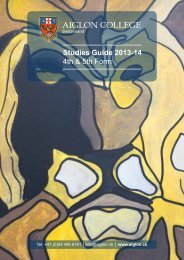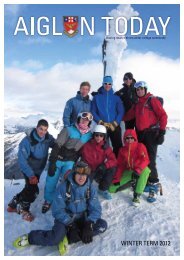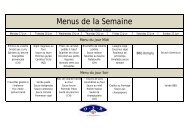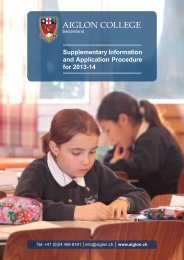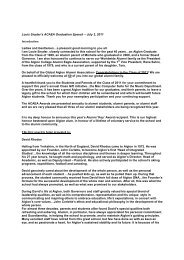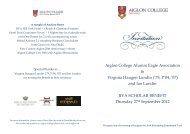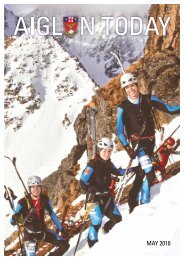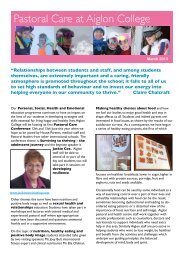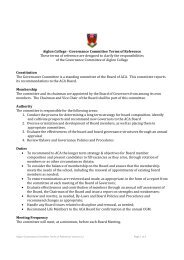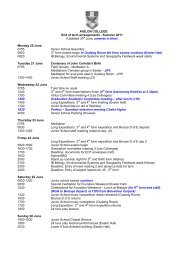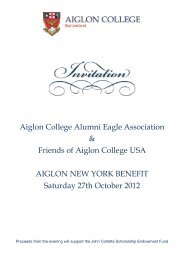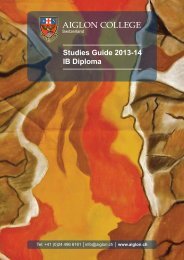Junior School Studies Guide - Aiglon College
Junior School Studies Guide - Aiglon College
Junior School Studies Guide - Aiglon College
- No tags were found...
Create successful ePaper yourself
Turn your PDF publications into a flip-book with our unique Google optimized e-Paper software.
PREPARATORY FORMS (PREP FORMS)ArtPrep Form 1: The programme aims to give pupils a basic understanding of many of the key elements of art: line,colour, tone, pattern, texture, shape and form. Pupils are introduced to colour theory, collage cut-outs,mono-printing and textile painting, and we will study world-renowned artists such as Piet Mondrian, WassilyKandinsky, Friedensreich Hundertwasser, Henri Matisse and Georgia O’Keefe. In addition we will look atmulticultural art - such as Aboriginal dot painting, African mask making and Native American textiles - tochallenge pupils’ relief, decorative, imaginative and 3D skills.Prep Form 2: The programme comprises 2D and 3D work, aiming to develop pupils’ knowledge andunderstanding of the key elements of art such as line, colour, tone, pattern, texture, shape and form. Pupils areintroduced to different techniques, including collage and printing, and use a range of materials such as charcoal,paint, ink, tin foil and cardboard as well as online resources. Vincent Van Gogh, Paul Klee, Jackson Pollock andGeorges Seurat are just some of the inspirational artists focused on during the year. 3D projects take differentforms, but include sculpture and mosaic-making.EnglishSyllabusEnglish follows the English National Curriculum Key Stage 2 in the Prep Forms, and Key Stage 3 in the 1stand 2nd Forms for those who are fluent or almost fluent English speakers.Our broader aims are to:• Enable pupils to develop as articulate speakers who can express themselves accurately and fluently, usingextended vocabulary;• Encourage pupils to develop good listening and concentration skills;• Enable pupils to be fluent, independent readers who enjoy reading for pleasure;• Give pupils the opportunity to experience a wide variety of reading materials and literature;• Teach pupils the correct forms of English grammar and punctuation;• Give pupils the opportunities to write under different stimuli and for a variety of reasons;• Encourage pupils to present their work neatly, in an organised fashion and using extended vocabularyin the correct contexts.English as a Second LanguageThe ESL Programme, available in Prep Forms and the 1st and 2nd Forms, aims to:• Develop pupils’ listening and comprehension skills through oral activities and games;• Enable them to use English grammar and tenses correctly;• Develop their skills in sentence structures and English usage, both in the written and spoken forms;• Provide opportunities to learn and practise a wide range of vocabulary through reading, written workand especially oral work;• Encourage them to learn to read and articulate in English, and to develop as fluent independentreaders;• Gradually develop their written skills so they can write comprehensively for different purposes e.g.stories, conversations, explanations and descriptions.How will my child cope in a mixed ability language class?There are several language levels within our small class groups where pupils work with two or three others ofsimilar ability to either make a start on their English or build on to the English they already have. As the yearprogresses, so too do the pupils’ language abilities, and the beginners in ESL often reach a stage in the courseof the year where they can merge with and work alongside mainstream pupils and benefit from the experienceof the English speakers.<strong>Aiglon</strong> <strong>Junior</strong> <strong>School</strong> <strong>Studies</strong> <strong>Guide</strong> 2013-14 5



